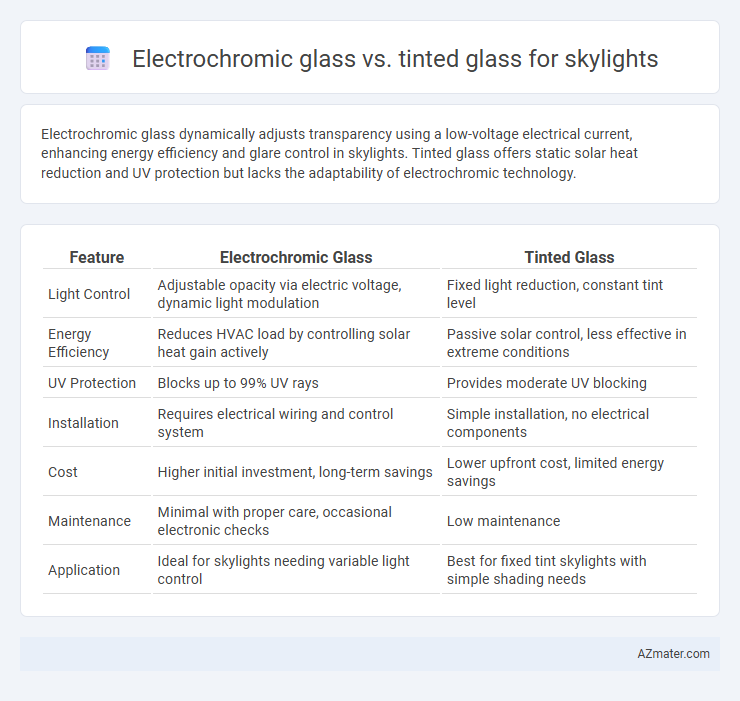Electrochromic glass dynamically adjusts transparency using a low-voltage electrical current, enhancing energy efficiency and glare control in skylights. Tinted glass offers static solar heat reduction and UV protection but lacks the adaptability of electrochromic technology.
Table of Comparison
| Feature | Electrochromic Glass | Tinted Glass |
|---|---|---|
| Light Control | Adjustable opacity via electric voltage, dynamic light modulation | Fixed light reduction, constant tint level |
| Energy Efficiency | Reduces HVAC load by controlling solar heat gain actively | Passive solar control, less effective in extreme conditions |
| UV Protection | Blocks up to 99% UV rays | Provides moderate UV blocking |
| Installation | Requires electrical wiring and control system | Simple installation, no electrical components |
| Cost | Higher initial investment, long-term savings | Lower upfront cost, limited energy savings |
| Maintenance | Minimal with proper care, occasional electronic checks | Low maintenance |
| Application | Ideal for skylights needing variable light control | Best for fixed tint skylights with simple shading needs |
Introduction to Skylight Glazing Technologies
Electrochromic glass offers dynamic light control and energy efficiency by adjusting transparency in response to electrical input, making it ideal for modern skylight applications. Tinted glass provides a static solution by reducing glare and UV penetration through permanent coloration, suitable for cost-effective shading. Both glazing technologies enhance indoor comfort but differ significantly in adaptability and energy management for skylight installations.
How Electrochromic Glass Works
Electrochromic glass for skylights changes its tint by applying a low-voltage electrical current, causing ions to move between layers, which alters the glass's light transmittance and heat control properties. Unlike traditional tinted glass that has a fixed opacity, electrochromic glass dynamically adjusts to sunlight intensity, enhancing energy efficiency and occupant comfort. This smart glazing technology reduces glare and solar heat gain while maintaining natural daylight, optimizing indoor environments throughout the day.
Understanding Tinted Glass for Skylights
Tinted glass for skylights reduces solar heat gain and glare by incorporating color pigments during manufacturing, effectively enhancing energy efficiency and occupant comfort. Unlike electrochromic glass, which dynamically adjusts transparency in response to electrical signals, tinted glass offers a fixed level of shading and light transmission tailored to specific environmental conditions. Common tint options include grey, bronze, and blue, each balancing visible light transmittance (VLT) and thermal performance to protect interiors from UV radiation while preserving natural daylight.
Light Control and Comfort Comparison
Electrochromic glass offers dynamic light control by adjusting its tint electronically, reducing glare and heat while maintaining clear views, enhancing comfort in skylights. Tinted glass provides a fixed shading level that passively limits sunlight and heat but cannot adapt to changing light conditions, which may result in inconsistent comfort. Electrochromic skylights optimize energy efficiency and occupant comfort through customizable transparency, surpassing the static performance of tinted glass.
Energy Efficiency: Electrochromic vs Tinted Glass
Electrochromic glass outperforms tinted glass in energy efficiency for skylights by dynamically adjusting its tint based on sunlight intensity, reducing solar heat gain and minimizing HVAC loads. Unlike static tinted glass, electrochromic technology optimizes natural light while maintaining thermal control, resulting in significant energy savings throughout the day. This adaptive feature enhances building comfort and lowers electricity consumption, making electrochromic glass a superior choice for sustainable skylight solutions.
Smart Features and Automation
Electrochromic glass for skylights offers dynamic light and heat control through smart features like app integration, voice control, and automated tint adjustments based on ambient conditions, enhancing energy efficiency and comfort. Tinted glass provides static shading without automation, limiting its adaptability to changing sunlight and temperature throughout the day. The advanced automation in electrochromic glass enables seamless environment customization, outperforming traditional tinted glass in modern smart building applications.
Aesthetics and Design Flexibility
Electrochromic glass offers dynamic tinting capabilities, allowing users to adjust transparency levels for optimal natural light control and privacy, enhancing aesthetic versatility in skylight design. Unlike static tinted glass, which provides a fixed shade and limits design options, electrochromic glass supports seamless integration with smart home systems and modern architectural trends. This adaptability promotes innovative design solutions and elevates the visual appeal of residential and commercial skylights.
Installation and Maintenance Requirements
Electrochromic glass for skylights requires professional installation to integrate electronic controls and wiring, while tinted glass involves simpler, standard glazing installation without electrical components. Maintenance of electrochromic glass includes periodic checks of the electronic system and potential window controller updates, whereas tinted glass demands only routine cleaning with no specialized upkeep. The complexity of electrochromic glass installation and maintenance costs are higher but offer dynamic light control, contrasting with the static nature and lower costs of tinted glass maintenance.
Cost Considerations and ROI
Electrochromic glass for skylights typically involves higher upfront costs due to advanced smart technology and installation complexity, but it offers significant energy savings by dynamically controlling solar heat gain and glare, leading to a faster ROI in energy-efficient buildings. Tinted glass has lower initial expenses and requires minimal maintenance, yet its static shading limits energy savings and ROI compared to electrochromic options. Businesses aiming for long-term value should weigh the higher initial investment in electrochromic glass against potential reductions in HVAC costs and enhanced occupant comfort.
Choosing the Best Skylight Solution for Your Space
Electrochromic glass offers dynamic light control and energy efficiency, adjusting tint levels automatically to reduce glare and heat gain in skylights. Tinted glass provides a fixed shading solution that limits solar heat but lacks adaptability to changing sunlight conditions. For selecting the best skylight, prioritize energy savings, comfort, and natural light modulation, making electrochromic glass the superior choice for flexible and sustainable daylight management.

Infographic: Electrochromic glass vs Tinted glass for Skylight
 azmater.com
azmater.com